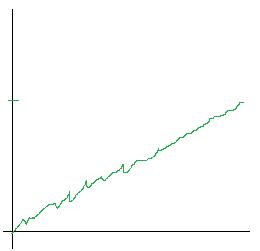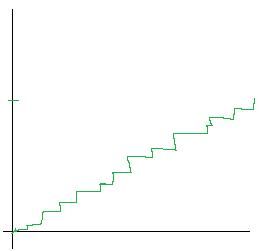Either betting or trading in Betfair, we should always green up to control our bankroll’s variance. Instead of staring at our screen after accumulating profit or loss on our selection and hoping it either wins or loses respectively, we should be creating a green book in the Betfair markets. Our gambling bankroll will thank us for that.
I have already shown how to trade in Betfair in simple steps and how to green up in Betfair in the end. In this article I will explain why greening up in Betfair will help our bankroll withstand the swings. I will consider 2 different betfair traders in this example who sit next to each other and they trade in exactly the same way. Their only difference in their trading style is that the first one ALWAYS greens up while the second trader never does. So, let’s assume they trade profitably in 100 races (exaggerating example of course). The first trader’s bankroll will increase in the following way:

Trader B won’t win anything in most races though, since his selection won’t win every race and when it doesn’t, he wins $0.00, that is the amount on other horses. His bankroll will also increase in a slightly different way, something like this:

In the end both traders show about the same profit. The reason behind this is that the probability their selection to win each race is usually around the odds of their selection just before the race. For instance, if a horse is traded at 2.00, then it will win the race about 50% of the time. Out of 10 races trader B will win X amount 5 times while trader A will win X/2 10 times, since he greens up, dividing the total amount by the odds at that time (2.00).
Up to now everything looks fine and we can agree that there is no big difference in the performance of the two traders. Things change a lot if they lose in some races. Let’s say that in 10 races the horse the two traders traded was at 5.00 odds. They lost $100 in 5 races while they won the same amount in the rest. Trader A greens up and loses $20 in 5 races no matter the outcome, and wins $20 in the other 5. He finally breaks even.
Trader B on the other hand does not green up. Each horse has about 20% probability to win each race. The trader will win 2 races. If he is “lucky” and the horse wins when he traded profitably, he will win $200. However, if he is “unlucky” and the horse wins when he traded unprofitably, he will lose $200. At the same time I remind you that trader A had broken even. Who was right?
Both! The issue is how they handle the variance in their bankrolls. If they want as little variance as possible, they have to green up all the amount and in every race. If not, they can leave the amount they have won or lost untouched and their bankrolls will look like this:

In the end of the day their performance will be about the same, unless trader B is extremely “lucky” or “unlucky”. The more races they trade though, the closer the final result for both traders. Because I have yet to meet someone who likes the swings of their bankroll, my advice is to always green up your profit or your loss.
ATTENTION though! Pay a lot of attention now! NEVER green up only your wins and let your losses run. Do not be selective in your greening up, decide if you are going to green up or never green up. If you begin to pick the races you green up, you jeopardize picking out your losses when the horses win and win the small amounts when you green up and the horses win (since only then you’ll be greening up). On the other hand, if you decide not to green up your profits, you may lose the profit you had secured when that horse loses, but you will always suffer losses when you have done bad trading, since you would have been greening up.
Stay faithful to yourself and your decisions and let statistics take care of your bankroll’s variance!


